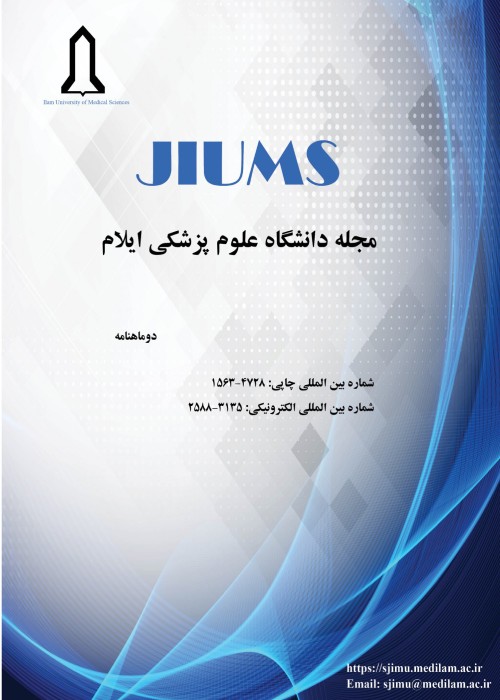Antioxidant Activity of Glycyrrhiza glabra L. Extract and Protective Effect of its Leaf Extract on Ethanol-Induced Nephrotoxicity in Male Rats
Author(s):
Article Type:
Research/Original Article (دارای رتبه معتبر)
Abstract:
Introduction
Acute alcohol consumption leads to induction of lipid peroxidation in renal tissues, but its chronic consumption has moderate effects on biochemical and histological characteristics of this organ. Antioxidants have protective effects against ethanol-induced oxidative stress and tissue injury. The aim of this study was to assess antioxidant activity of Glycyrrhiza glabra leaf and stem extracts and the protective effect of its leaf extract on ethanol-induced nephrotoxicity.Materials & methods
Total phenol and flavonoid contents of leaf and stem extracts of G. glabra were measured by Folin Ciocalteu and AlCl3 assays, respectively. Antioxidant activity of both extracts was assessed using 2, 2-diphenyl-1-picrylhydrazyl (DPPH) free radical scavenging. In addition, protective effect of the leaf extract was assessed using biochemical and histological analyses of renal tissues of male Wistar rats, which were divided into four groups including group 1 or control (received 1 ml distilled water daily), group 2 or ethanol group (received 1 ml of 50% ethanol daily), group 3 or ethanol + leaf extract group (received 1 ml of 50% ethanol + 500 mg/kg leaf extract daily), and group 4 (received 500 mg/kg of leaf extract daily). All treatments are performed through intragastric administration. Biochemical and histological analyses were used for the evaluation of nephrotoxicity. For histological study, the samples were stained with Hematoxylin-Eosin and examined by light microscopy. Finally, all the data were analyzed by SPSS (Ver. 20) and grouped by Duncan's Multiple Range Test at P <0.05 level.Findings: There was no significant difference between total phenol contents of the stem and leaf extracts. However, the stem extract showed a higher total flavonoid content than the leaf extract. Also, both the extracts showed higher antioxidant activities (86-93%) than that of ascorbic acid (71%). Results from biochemical analysis indicated a significant increase in superoxide dismutase (SOD) activity and H2O2 content in the renal tissues of ethanol-treated rats in comparison with other groups; however, there were no significant changes in total protein and malondialdehyde (MDA) contents. Results from histological examination showed that alcohol consumption intensity injured kidney tissues, which was effectively moderated by the studied extract.
Discussion & Conclusions: Results from the present study showed that G. glabra extract has biological activity and can be used in future as a new natural antioxidant in food and drug industries.
Keywords:
Language:
Persian
Published:
Ilam University of Medical Science, Volume:26 Issue: 4, 2018
Pages:
1 to 12
magiran.com/p1905401
دانلود و مطالعه متن این مقاله با یکی از روشهای زیر امکان پذیر است:
اشتراک شخصی
با عضویت و پرداخت آنلاین حق اشتراک یکساله به مبلغ 1,390,000ريال میتوانید 70 عنوان مطلب دانلود کنید!
اشتراک سازمانی
به کتابخانه دانشگاه یا محل کار خود پیشنهاد کنید تا اشتراک سازمانی این پایگاه را برای دسترسی نامحدود همه کاربران به متن مطالب تهیه نمایند!
توجه!
- حق عضویت دریافتی صرف حمایت از نشریات عضو و نگهداری، تکمیل و توسعه مگیران میشود.
- پرداخت حق اشتراک و دانلود مقالات اجازه بازنشر آن در سایر رسانههای چاپی و دیجیتال را به کاربر نمیدهد.
دسترسی سراسری کاربران دانشگاه پیام نور!
اعضای هیئت علمی و دانشجویان دانشگاه پیام نور در سراسر کشور، در صورت ثبت نام با ایمیل دانشگاهی، تا پایان فروردین ماه 1403 به مقالات سایت دسترسی خواهند داشت!
In order to view content subscription is required
Personal subscription
Subscribe magiran.com for 70 € euros via PayPal and download 70 articles during a year.
Organization subscription
Please contact us to subscribe your university or library for unlimited access!


